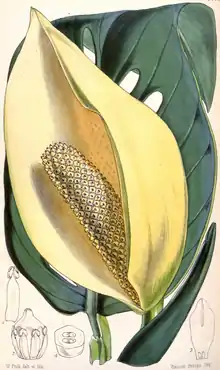Monstera adansonii
Monstera adansonii, the Adanson's monstera,[2] Swiss cheese plant,[3] or five holes plant, is a species of flowering plant from family Araceae which is widespread across much of South America and Central America.[4] Besides South American countries it can also be found in the West Indies on islands such as Antigua, Grenada, Saba, St. Kitts, Guadeloupe, Marie Galante, Dominica, Martinique, St. Lucia, St. Vincent, Tobago, and Trinidad. The species is quite common near river valleys at lower elevations.[5]
| Monstera adansonii | |
|---|---|
 | |
| Scientific classification | |
| Kingdom: | Plantae |
| Clade: | Tracheophytes |
| Clade: | Angiosperms |
| Clade: | Monocots |
| Order: | Alismatales |
| Family: | Araceae |
| Genus: | Monstera |
| Species: | M. adansonii |
| Binomial name | |
| Monstera adansonii | |
| Synonyms[1] | |
| |
Description
Scandent hemiepiphyte 2 – 4 (-6) m tall. Juvenile: terrestrial creeper, stem smooth, green, terete, internodes 1 – 6 cm long; petiole vaginate for 1/3 to 5/6 its length, the lamina widely ovate to narrowly elliptic, entire or perforated at a very early stage when only 5 – 10 cm long. Adult stem: subterete, green, smooth, 1.5 – 3.0 cm thick, the internodes 3 – 10 cm long; leaf scars shallow, 3 – 10 mm wide at the widest point, the ends of each leaf scar overlapping for 3 – 6 mm; axillary buds longer than wide, located in a depression which is not extended into a sulcus. Petiole: smooth, 20 – 60 cm long, somewhat shorter than the lamina, vaginate to the geniculum, the wings of the sheath deciduous or persistent, the geniculum 3 – 5 cm long. Lamina: subcoriaceous, glossy adaxially, very widely ovate to elliptic, 25 – 70 cm long, 15 – 45 cm wide, the base cuneate to broadly truncate, sometimes oblique and unequal, being cuneate on one side and truncate to subcordate on the other side, the tip acute or shortly mucronate; margin entire, rarely irregularly laciniate, perforations absent to numerous in several series on each side of the midrib; primary lateral veins parallel, 8 – 16 in number, secondary lateral veins parallel to the primaries. Peduncle: smooth, green, subterete to flattened, 9 – 22 cm long, 1.0 – 1.4 cm thick, 1.1 – 2.0 cm wide. Spathe: cream to pale yellow, coriaceous, 12 – 28 cm tall, 10 – 25 cm around, acuminate, opening widely at maturity. Flowering spadix: cream to yellow,cylindric, 8 – 13 cm long, 1.1 – 2.6 cm thick, the pistils 4 – 7 mm long, truncate or acute at the apex, the lower 6 – 8 rows of flowers sterile. Fruiting spadix: green, becoming yellow to deep yellow at maturity, 10 – 17 cm long, 2 – 4 cm thick, the stylar portion of the pistil containing trichosclereids, deciduous, revealing the seeds in a gray pulp. Berries mostly one-seeded, the seeds brown or black, 5 – 7 mm long, 4 – 6 mm wide, 2 – 3 mm thick.[6]
There is one cultivar named Monstera adansonii 'Archipelago' which has variegated leaves, much like M. deliciosa 'Variegata'. Rare but reasonably common to find in the USA and Asia.
References
- "Monstera adansonii - Costela-de-adão". Flora SBS. Retrieved June 4, 2013.
- "Monstera adansonii". Natural Resources Conservation Service PLANTS Database. USDA. Retrieved 13 July 2015.
- Wiersema, John H.; León, Blanca (2016). World Economic Plants: A Standard Reference (2nd ed.). CRC Press. p. 452. ISBN 9781466576810 – via Google Books.
- "Monstera adansonii Schott". University of Connecticut. Retrieved June 4, 2013.
- "Monstera adansonii Schott, Wiener Z. Kunst". pp. 1028–1830.
- Madison, Michael. (1977). A revision of Monstera (Araceae). Gray Herbarium of Harvard University. OCLC 4789055.
![]() Media related to Monstera adansonii at Wikimedia Commons
Media related to Monstera adansonii at Wikimedia Commons